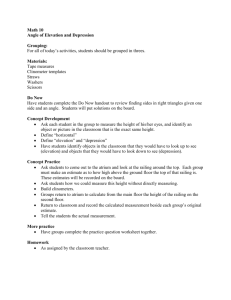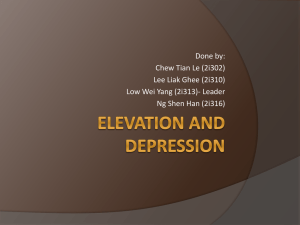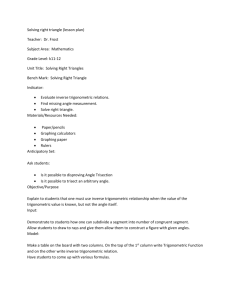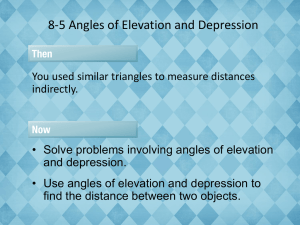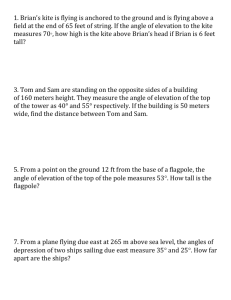Indirect_Measurements_Lesson
advertisement
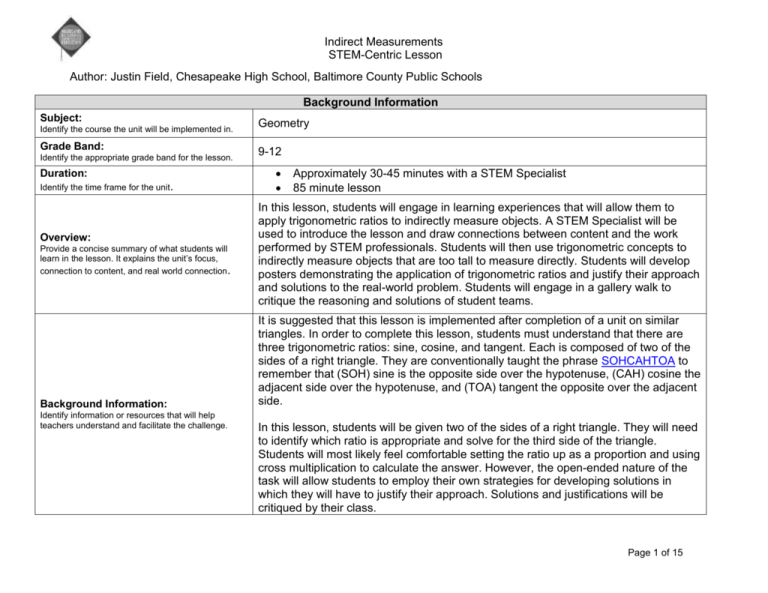
Indirect Measurements STEM-Centric Lesson Author: Justin Field, Chesapeake High School, Baltimore County Public Schools Background Information Subject: Identify the course the unit will be implemented in. Grade Band: Identify the appropriate grade band for the lesson. Duration: Identify the time frame for the unit. Overview: Provide a concise summary of what students will learn in the lesson. It explains the unit’s focus, connection to content, and real world connection. Background Information: Identify information or resources that will help teachers understand and facilitate the challenge. Geometry 9-12 Approximately 30-45 minutes with a STEM Specialist 85 minute lesson In this lesson, students will engage in learning experiences that will allow them to apply trigonometric ratios to indirectly measure objects. A STEM Specialist will be used to introduce the lesson and draw connections between content and the work performed by STEM professionals. Students will then use trigonometric concepts to indirectly measure objects that are too tall to measure directly. Students will develop posters demonstrating the application of trigonometric ratios and justify their approach and solutions to the real-world problem. Students will engage in a gallery walk to critique the reasoning and solutions of student teams. It is suggested that this lesson is implemented after completion of a unit on similar triangles. In order to complete this lesson, students must understand that there are three trigonometric ratios: sine, cosine, and tangent. Each is composed of two of the sides of a right triangle. They are conventionally taught the phrase SOHCAHTOA to remember that (SOH) sine is the opposite side over the hypotenuse, (CAH) cosine the adjacent side over the hypotenuse, and (TOA) tangent the opposite over the adjacent side. In this lesson, students will be given two of the sides of a right triangle. They will need to identify which ratio is appropriate and solve for the third side of the triangle. Students will most likely feel comfortable setting the ratio up as a proportion and using cross multiplication to calculate the answer. However, the open-ended nature of the task will allow students to employ their own strategies for developing solutions in which they will have to justify their approach. Solutions and justifications will be critiqued by their class. Page 1 of 15 Indirect Measurements STEM-Centric Lesson STEM Specialist Connection: Describe how a STEM Specialist may be used to enhance the learning experience. STEM Specialist may be found at http://www.thestemnet.com/ Enduring Understanding: Identify discrete facts or skills to focus on larger concepts, principles, or processes. They are transferable - applicable to new situations within or beyond the subject. Essential Questions: Identify several open-ended questions to provoke inquiry about the core ideas for the lesson. They are grade-level appropriate questions that prompt intellectual exploration of a topic. Student Outcomes: Identify the transferable knowledge and skills that students should understand and be able to do when the lesson is completed. Outcomes must align with but not limited to Maryland State Curriculum and/or national standards. Product, Process, Action, Performance, etc.: Identify what students will produce to demonstrate that they have met the challenge, learned content, and employed 21st century skills. Additionally, identify the audience they will present what they have produced to. Background Information A STEM Specialist can be used during the engagement portion of the lesson to introduce trigonometric ratios and engage students in hands-on learning experiences that demonstrate how these ratios are employed by STEM professionals. The recommended STEM Specialist for this lesson is Kate McGuire, an engineer from Northrop Grumman. Her profile and contact information may be found at http://www.thestemnet.com/. Indirect measurements may be used to determine the height of objects that are too tall to measure directly. STEM professionals employ trigonometric ratios to solve problems. 1. How can technological tools be used to indirectly measure tall objects? 2. How can trigonometric ratios be applied to solve real-world problems? 3. How do STEM professional use trigonometric ratios? Students will be able to: 1. employ technological tools to indirectly determine the height of a various objects. 2. use trigonometric ratios to solve right triangles in applied problems. Students will work in teams to create posters demonstrating the application of trigonometric ratios to develop solutions to realworld problems. Students will participate in a gallery walk to critique the solution and approach of each other’s work. Audience: ☒Peers ☐Experts / Practitioners ☒Teacher(s) ☐School Community ☐Online Community ☐Other______ Page 2 of 15 Indirect Measurements STEM-Centric Lesson Background Information Domain: Similarity, Right Triangles, and Trigonometry Standards Addressed in the Unit: Identify the Maryland State Curriculum Standards addressed in the unit. Suggested Materials and Resources: Identify materials needed to complete the unit. This includes but is not limited to websites, equipment, PowerPoints, rubrics, worksheets, and answer keys. Cluster Statement: Define trigonometric ratios and solve problems involving right triangles. Standard: Use trigonometric ratios and the Pythagorean Theorem to solve right triangles in applied problems. Equipment: Calculator Inclinometer (If inclinometers are not available, students can make their own following the instructions here >> http://www.exploratorium.edu/math_explorer/howHigh_makeInclino.html) Pedometer Large sheet of paper (newsprint, easel pad paper, etc.) Tape Document camera or other device to project problems to the class. People, Facilities: STEM Specialist Students will need access to the school’s flagpole or other tall object such as a streetlight or a tree. Materials: Angles of Depression and Elevation Handout Angles of Depression and Elevation Answer Key Page 3 of 15 Indirect Measurements STEM-Centric Lesson Learning Experience 5E Component Identify the 5E component addressed for the learning experience. The 5E model is not linear. ☒Engagement ☐Exploration Details Materials: Technology needs of the STEM Specialist. Angles of Depression and Elevation Student Note Sheet. ☐Evaluation ☐Make sense of problems and persevere in solving them. ☐Reason abstractly and quantitatively. ☐Explanation ☐Extension Standards for Mathematical Practice Preparation: Contact the STEM Specialist in advance to co-plan the lesson and explain his/her role in facilitating instruction. Provide the STEM Specialist a description of the ability level of the students and the prior knowledge your students may have of trigonometric ratios. Discuss available technology and classroom set-up with the Specialist. Prepare a list of questions to help guide the learning experience with the STEM Specialist or have students prepare some questions in advance. Students will need one copy of the Angles of Depression and Elevation Student Note Sheet. Facilitation of Learning Experience: The STEM Specialist will be responsible for engaging students in a hands-on learning experiences that demonstrates how he/she employs mathematical modeling in his/her field and how technological tools can be used to indirectly measure objects. By the end of the learning experience, students will be able to explain how trigonometry is used to indirectly measure an object and how STEM professional employ trigonometric ratios. The STEM Specialist will discuss various professions (air traffic controllers, pilots, astronomer, etc.) and ☐Construct viable arguments and critique the reasoning of others. ☒Model with mathematics. ☒Use appropriate tools strategically. ☐Attend to precision. ☐Look for and make use of structure. ☐Look for and express regularity in repeated reasoning. Page 4 of 15 Indirect Measurements STEM-Centric Lesson Learning Experience 5E Component Identify the 5E component addressed for the learning experience. The 5E model is not linear. Details Standards for Mathematical Practice how they use trigonometry to solve problems. The STEM Specialist will aid students in discovering: 1. What is an angle of depression and an angle of elevation? 2. What are the three trigonometric ratios? 3. What is the significance of learning about angles of depression and elevation and trigonometric ratios? 4. How are angles of depression and elevation, trigonometric ratios, and other trigonometry concepts used by STEM professionals? 5. How can situations of distance be described using a right triangle? 6. How can trigonometry be used to indirectly measure objects? Students will answer the first six questions on the Angles of Depression and Elevation Student Note Sheet. Transition: Inform students that in next class, they will use inclinometers and pedometers to take measurements in order to indirectly measure the height of tall objects around the school. Students will work in teams to develop solutions to problems similar to the ones presented by the STEM Specialist. Inform students as they leave to think about how trigonometry is related to the situations presented today and the three trigonometric ratios we have learned so far. Page 5 of 15 Indirect Measurements STEM-Centric Lesson Learning Experience 5E Component Identify the 5E component addressed for the learning experience. The 5E model is not linear. ☐Engagement ☒Exploration ☐Explanation ☐Extension ☐Evaluation Details Materials: Calculator Inclinometer Pedometer Large sheet of paper (newsprint, easel pad paper, etc.) Tape Angles of Depression and Elevation Student Note Sheet Angels of Depression and Elevation Student Note Sheet Answer Key Preparation: Make sure all materials are accessible to students. Each student team will need one calculator, one inclinometer, one pedometer, and one large sheet of paper. Standards for Mathematical Practice ☒Make sense of problems and persevere in solving them. ☐Reason abstractly and quantitatively. ☒Construct viable arguments and critique the reasoning of others. ☒Model with mathematics. ☒Use appropriate tools strategically. ☐Attend to precision. Facilitation of Learning Experience: Divide students into small teams. Ask students, “if you need to know the height of an object what would you do?” Expected student response is to measure it with a ruler, tape measure, etc. Follow up by asking students, “What if you needed to know the height of a tree or a building? How could you measure this height without using a ruler or tape measure?” Accept all responses. Ideally, students will recall information learned from the STEM Specialists. Inform students that today they will indirectly determine the height of objects. ☐Look for and make use of structure. ☐Look for and express regularity in repeated reasoning. Provide each team with a pedometer. Explain what a pedometer is and how it works. Allow students to practice using the pedometer. Once students are comfortable using the pedometer, provide teams with an inclinometer. Explain Page 6 of 15 Indirect Measurements STEM-Centric Lesson Learning Experience 5E Component Identify the 5E component addressed for the learning experience. The 5E model is not linear. Details Standards for Mathematical Practice what an inclinometer is and how it works. Allow students to practice using the inclinometer. (Note to teacher: Additional time and materials will be required if students have to make their own inclinometer. Instructions on how to make an inclinometer may be found here >> http://www.exploratorium.edu/math_explorer/howHigh_makeInclino.html.) Explain to students that they will use these devices to indirectly measure the height of specific objects around the school. Take student teams to the school’s flag pole (or other tall object if flagpole is not available). Have them draw a freehand diagram of the flagpole and where they are standing in relationship to the flagpole. Students will use the pedometer to measure their distance from the flagpole and the inclinometer for angle measurement. They must include measurements from the pedometer and the inclinometer on their drawings. Each team could be different distance from the flag pole. Tell students that using the information provided and their prior knowledge, they have to determine the height of the flagpole. Students must be able to justify their answers. Allow teams to brainstorm a solution to the problem using the data they have collected. After all teams have developed solutions, engage teams in a discussion about how they developed their solutions. Confirm correct answers and provide guidance for struggling teams. If necessary, guide students through the calculations required to determine the height of the flagpole. Once teams are comfortable using trigonometric ratios to indirectly measure an object, instruct each team to select different objects to determine its height (tree, street light, etc.). Teams will use the inclinometer and pedometer to determine the height of their selected object. Provide guidance to student teams as Page 7 of 15 Indirect Measurements STEM-Centric Lesson Learning Experience 5E Component Identify the 5E component addressed for the learning experience. The 5E model is not linear. Details Standards for Mathematical Practice necessary. Bring students back to the classroom. Call on teams to discuss the height of their selected object. They should discuss how they determined the height and their solution. Provide each team a large sheet of paper (newsprint, easel pad paper, etc.) Refer students the six problems on the student note sheet. Assign each group one problem to solve. Students will create a poster that contains a title, the problem, an accurately labeled diagram, the solution to the problem and a brief paragraph explaining how they developed the solution. Monitor group progress and provide guidance as necessary. Gallery Walk: Instruct teams to hang their posters around the classroom. Student teams will rotate to each poster and review the problem and discuss the solution. Student teams will determine if the solutions presented on posters are accurate. They will record solutions and notes from discussion beneath the gallery walk section on their student note sheet. After teams have analyzed all posters, have student return to their seats. Engage students in discussion about each of the scenarios calling on teams to share their responses. Confirm correct answers to problems. Have students work through problems that teams inaccurately solved. If time constraints exist, the teacher should prepare a discussion from the least efficient/precise to most efficient/precise approach and solution. Transition: If time permits, move to the extension activity. The extension activity may also be used as a homework assignment. Page 8 of 15 Indirect Measurements STEM-Centric Lesson Learning Experience 5E Component Identify the 5E component addressed for the learning experience. The 5E model is not linear. ☐Engagement ☐Exploration ☐Explanation ☒Extension ☐Evaluation Details Materials: Document camera or other device to project problems to the class. Angles of Depression and Elevation Student Note Sheet Preparation: Inform students to take out a blank sheet of paper. Facilitation of Learning Experience: Project the following problem for the class to see. As a class, work through the problem below: A pilot flying at an altitude of 3 km sights two control towers directly in front of him. The angle of depression the base of one tower is 37°. The angle of depression to the base of the other tower is 57°. What is the distance between the two towers? Round to the nearest tenth of a kilometer. Answer: 3(tan 57o-tan 37o) = 2.36 km Exit ticket: Project the problem below for the class to see. Students will submit the answer to the problem on their exit ticket. Standing at the top of a 200 meter canyon and looking down at a river below, you notice that the angle of depression to the near side bank of the river is 60 0 and 760 to the far bank. How wide is the river? Answer: 200(tan 76o-tan 60o)=455.75 meters Standards for Mathematical Practice ☒Make sense of problems and persevere in solving them. ☐Reason abstractly and quantitatively. ☐Construct viable arguments and critique the reasoning of others. ☐Model with mathematics. ☐Use appropriate tools strategically. ☐Attend to precision. ☐Look for and make use of structure. ☐Look for and express regularity in repeated reasoning. Page 9 of 15 Indirect Measurements STEM-Centric Lesson Learning Experience 5E Component Identify the 5E component addressed for the learning experience. The 5E model is not linear. ☐Engagement ☐Exploration ☐Explanation ☐Extension ☒Evaluation Details Materials: Calculator Inclinometer Pedometer Preparation: Provide each student with the materials listed above. Facilitation of Learning Experience: End Assessment 1. Students will individually measure the height of the school using inclinometers and pedometers. 2. Students will use the height of the school to measure of the width of the sidewalk by calculating two separate angles of elevation on either side. 3. Students will explain how they developed their solution and justify why their answer is correct. Standards for Mathematical Practice ☒Make sense of problems and persevere in solving them. ☒Reason abstractly and quantitatively. ☐Construct viable arguments and critique the reasoning of others. ☐Model with mathematics. ☐Use appropriate tools strategically. ☐Attend to precision. ☐Look for and make use of structure. ☐Look for and express regularity in repeated reasoning. Page 10 of 15 Indirect Measurements STEM-Centric Lesson Interventions/Enrichments Identify interventions and enrichments for diverse learners. Supporting Information Special Education/Struggling Learners Instructors can create teams based upon ability, learning style, or other appropriate criteria, so all students can equally contribute to the team assignment. Scaffold note sheet as needed. Establish specific deadlines for work completion with the teams so class time is effectively used. Provide resources to define and/or pronounce difficult vocabulary, especially when teams are discussing angle of elevation and angle of depression. Break work into chunks for teams, so they are able to achieve small goals and meet all expectations. Provide additional time for work completion or assign some parts of the assignment for homework. English Language Learners Strategies to help English Language Learners are similar to those listed above. Provide resources to define and/or pronounce difficult vocabulary. A native language dictionary may also be beneficial. Use visuals (pictures displayed on a document camera or PowerPoint presentation) when appropriate. Read directions and documents aloud to students, when appropriate. Gifted and Talented The instructor will foster independent thinking and collaboration between the partners. No one student should take over the work for the partnership. Higher level thinking questions should be asked throughout the lesson with the expectation of responses that are thoughtful and elaborate. Page 11 of 15 Name: Angles of Depression and Elevation Student Note Sheet. STEM Specialist: Ms. Mcguire of Northrup Grumman Directions: On a separate sheet of paper answer the following questions: 1. What is an angle of depression and an angle of elevation? 2. What are the three trigonometric ratios? 3. What is the significance of learning about angles of depression and elevation and trigonometric ratios? 4. How are angles of depression and elevation, trigonometric ratios, and other trigonometry concepts used by STEM professionals? 5. How can situations of distance be described using a right triangle? 6. How can trigonometry be used to indirectly measure objects? Flag Pole Directions: Draw a diagram and equation to calculate the height of the school’s flag pole using an inclinometer and a pedometer. Your object: ________________________ Directions: Use an inclinometer and a pedometer to calculate the height of a specified object. 1. Air Traffic Controller Directions: An air traffic controller at an airport sights a plane at an angle of elevation of 38°. The pilot reports that the plane’s altitude is 3500 ft. What is the horizontal distance between the plane and the airport. Round to the nearest foot. 2. Forest Rangers Directions: A forest ranger in a 90-foot observation tower sees a fire. The angle of depression to the fire is 7°. What is the horizontal distance between the tower and the fire? Round to the nearest foot. 3. Space Shuttle Directions: Brenda is watching a space shuttle launch. She is seated a mile away from the launch pad and her Smartphone inclinometer measures an angle of elevation at 70°. How high up is the space shuttle at that point? Round to the nearest foot. 4. Kites Directions: A kite is attached to a post a 4 ft tall post by a string at an angle of 650. The kite is on a string that is 55 meters long, how high in the air is it? 5. Canyon River Directions: Standing at the top of a 200 meter canyon and looking down at a river below, you notice that the angle of depression to the near side bank of the river is 600 and 760 to the far bank. How wide is the river? 6. Two Towers Directions: A pilot flying at an altitude of 2.7 km sights two control towers directly in front of her. The angle of depression the base of one tower is 37°. The angle of depression to the base of the other tower is 58°. What is the distance between the two towers? Round to the nearest tenth of a kilometer. Group Situation and individual work Directions: Use the space below to solve for the topic assigned to your group from 1-6 on the previous page. Gallery Walk Directions: Write down the solutions and discussion notes from the five other scenarios below. 1. Air Traffic Controller 2. Forest Ranger 3. Space Shuttle 4. Kites 5. Canyon River 6. Two Towers Exit Ticket Name: Angles of Depression and Elevation Student Note Sheet. – Answer Key STEM Expert: Ms. Mcguire of Northrup Grumman Directions: On a separate sheet of paper answer the following questions: 1. What is an angle of depression and an angle of elevation? 2. What are the three trigonometric ratios? 3. What is the significance of learning about angles of depression and elevation and trigonometric ratios? 4. How are angles of depression and elevation, trigonometric ratios, and other trigonometry concepts used by STEM professionals? 5. How can situations of distance be described using a right triangle? 6. How can trigonometry be used to indirectly measure objects? Flag Pole Directions: Draw a diagram and equation to calculate the height of the school’s flag pole using a inclinometer and a pedometer. Stand at the flag pole and walk approximately 10 meters away measuring with the pedometer. Measure the angle of elevation by pointing inclinometer from eye level to the top of the flagpole. Using the distance of 10 meters and the angle of elevation measurements set up the trigonometric ratio below Tan (angle of elevation = (flag pole height)/(distance away ’10 meters’) Cross multiplication or division can be used in order to solve. Students will brainstorm in teams how to find the answer. A teacher demonstration may be used in order to show struggling students how to use the pedometer and the inclinometer. However, do not reveal the procedure above until students have had the opportunity to work through it themselves. Teams will be responsible for reasoning through the situation and taking their own measurements. Your object: ________________________ Directions: Use a inclinometer and a pedometer to calculate the height of a specified object. Assign each team of have teams self-select an object and have them take pedometer and angle of elevation measurements. 1. Air Traffic Controller Directions: An air traffic controller at an airport sights a plane at an angle of elevation of 38°. The pilot reports that the plane’s altitude is 3500 ft. What is the horizontal distance between the plane and the airport. Round to the nearest foot. Ans: 4479.80 ft 2. Forest Rangers Directions: A forest ranger in a 90-foot observation tower sees a fire. The angle of depression to the fire is 7°. What is the horizontal distance between the tower and the fire? Round to the nearest foot. Ans:11.05 ft 3. Space Shuttle Directions: Brenda is watching a space shuttle launch. She is seated a mile away from the launch pad and her Smartphone inclinometer measures an angle of elevation at 70°. How high up is the space shuttle at that point? Round to the nearest foot. Ans: 2.75 miles 4. Kites Directions: A kite is attached to a post a 4 ft tall post by a string at an angle of 650. The kite is on a string that is 55 meters long, how high in the air is it? Ans: 53.85 ft 5. Canyon River Directions: Standing at the top of a 200 meter canyon and looking down at a river below, you notice that the angle of depression to the near side bank of the river is 600 and 760 to the far bank. How wide is the river? 6. Two Towers Directions: A pilot flying at an altitude of 2.7 km sights two control towers directly in front of her. The angle of depression the base of one tower is 37°. The angle of depression to the base of the other tower is 58°. What is the distance between the two towers? Round to the nearest tenth of a kilometer. Ans: 2.29 km Ans: 455.75 meters Group Situation and individual work Directions: Use the space below to solve for the topic assigned to your group from 1-6 on the previous page. Gallery Walk Directions: Write down the solutions and discussion notes from the five other scenarios below. 1. Air Traffic Controller 2. Forest Ranger 3. Space Shuttle 4. Kites 5. Canyon River 6. Two Towers Exit Ticket
